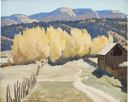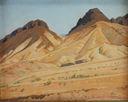(Lafayette) Maynard Dixon does not have an image.
(Lafayette) Maynard Dixon
(Fresno, CA, 1875 - 1946, Tucson, AZ)
Maynard Dixon was a product of the West. Born in 1875 in Fresno, California, his wonderful paintings of Western landscapes and of the American Indians epitomized a land and people that Americans wanted to romanticize. He first began painting desert scenes in a simplified, almost cubist manner. Later, after marrying the Depression-era photographer Dorothea Lange, Dixon turned to sad, stylized images of the Great Depression and turbulent views of city life. In the last years of his life, he turned again to the landscape of the West. A self-taught painter, he first visited Utah's Zion canyon in 1938. He immediately fell in love with the area and built a ten-acre summer residence at Mt. Carmel. For the remaining years of his life, Dixon passed his summers at Mt. Carmel and painted the Southern Utah landscape. Road to the River, Mt. Carmel, Utah depicts a view from behind his house, looking toward the Virgin River. In the small oil, he portrayed nature in a calming manner, contrasting the serene, blue mountains with the energetic, golden poplars. The artist chose to paint a simplified view of the area, subduing the foreground colors and creating strong geometric, almost cubist, figures. The contrasting colors and bold composition make the painting seem larger than it is. In addition, Maynard's approach to painting the road and its surroundings both created a relaxing view of the area and glorified its natural setting. He made no attempt to add details to make it more lovely, but painted it as he saw it, letting the beauty of the landscape stand for itself. According to Robert Olpin, “Dixon continues to be recognized as the greatest painter to capture the grandeur and monumentality of the Southern Utah landscape.“ Dixon's oeuvre is not stylistically classifiable. His life's works do not fit into one major movement, although they show the influence of the Impressionists, the Modernists, the Cubists, the Realists, and painters of the old West like Frederic Remington. Not always appreciated by the layman, Dixon's approach is appreciated by connoisseurs and artists. He was a social critic and a poet, fearlessly painting commentaries on the plight of the Native American and of victims of the Great Depression and social unrest. He lived among the figures he painted, actually spending time among the Hopi, Blackfoot, and Navajo Indians, and living in undeveloped Western areas like Taos, New Mexico, and Mt. Carmel. His character and his work make him one of the West's greatest painters. Ultimately, Dixon's goal was to touch our human side with his landscapes and scenes of the city. He wanted to allow us to feel. He makes this point in one of his poems, written under his trademark thunderbird signature, “This is my mark, / this is the mark I make / upon your heart.“ As he once said, “Painting, as I see it, must be human rather than arty--it is a means to an end. It is my way of saying what I want you to comprehend. It is my testimony in regard to life, and therefore I cannot lie in paint.“ Dixon died in 1946 and arranged for his ashes to be buried at a spot overlooking his beloved Mt. Carmel home.
(Fresno, CA, 1875 - 1946, Tucson, AZ)
Maynard Dixon was a product of the West. Born in 1875 in Fresno, California, his wonderful paintings of Western landscapes and of the American Indians epitomized a land and people that Americans wanted to romanticize. He first began painting desert scenes in a simplified, almost cubist manner. Later, after marrying the Depression-era photographer Dorothea Lange, Dixon turned to sad, stylized images of the Great Depression and turbulent views of city life. In the last years of his life, he turned again to the landscape of the West. A self-taught painter, he first visited Utah's Zion canyon in 1938. He immediately fell in love with the area and built a ten-acre summer residence at Mt. Carmel. For the remaining years of his life, Dixon passed his summers at Mt. Carmel and painted the Southern Utah landscape. Road to the River, Mt. Carmel, Utah depicts a view from behind his house, looking toward the Virgin River. In the small oil, he portrayed nature in a calming manner, contrasting the serene, blue mountains with the energetic, golden poplars. The artist chose to paint a simplified view of the area, subduing the foreground colors and creating strong geometric, almost cubist, figures. The contrasting colors and bold composition make the painting seem larger than it is. In addition, Maynard's approach to painting the road and its surroundings both created a relaxing view of the area and glorified its natural setting. He made no attempt to add details to make it more lovely, but painted it as he saw it, letting the beauty of the landscape stand for itself. According to Robert Olpin, “Dixon continues to be recognized as the greatest painter to capture the grandeur and monumentality of the Southern Utah landscape.“ Dixon's oeuvre is not stylistically classifiable. His life's works do not fit into one major movement, although they show the influence of the Impressionists, the Modernists, the Cubists, the Realists, and painters of the old West like Frederic Remington. Not always appreciated by the layman, Dixon's approach is appreciated by connoisseurs and artists. He was a social critic and a poet, fearlessly painting commentaries on the plight of the Native American and of victims of the Great Depression and social unrest. He lived among the figures he painted, actually spending time among the Hopi, Blackfoot, and Navajo Indians, and living in undeveloped Western areas like Taos, New Mexico, and Mt. Carmel. His character and his work make him one of the West's greatest painters. Ultimately, Dixon's goal was to touch our human side with his landscapes and scenes of the city. He wanted to allow us to feel. He makes this point in one of his poems, written under his trademark thunderbird signature, “This is my mark, / this is the mark I make / upon your heart.“ As he once said, “Painting, as I see it, must be human rather than arty--it is a means to an end. It is my way of saying what I want you to comprehend. It is my testimony in regard to life, and therefore I cannot lie in paint.“ Dixon died in 1946 and arranged for his ashes to be buried at a spot overlooking his beloved Mt. Carmel home.






